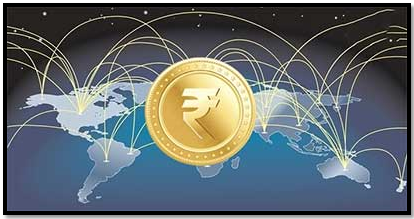INDIA’S QUEST FOR RUPEE GLOBALIZATION: CHALLENGES AND ROADMAP”
Syllabus:
- GS-3- Ruppee internationalization ,Economic development of nation, Forex reserves
Focus :
- The article delves into India’s ambition to internationalize the rupee, exploring the factors necessary for this transition, such as capital account convertibility, economic stability, and a robust export footprint. It highlights the steps taken so far, the challenges ahead, and draws comparisons with other nations like China, emphasizing that the journey towards making the rupee a global currency is gradual and complex.
Source - Livemint
Introduction: India’s Ambition for a Global Rupee
- India is increasingly focusing on internationalizing the rupee, with Finance Minister Nirmala Sitharaman proposing in the 2024-25 Budget to promote the currency for overseas investments.
- The idea is to turn the rupee into a “hard currency” — one that is stable both politically and economically.
- Success will depend on factors such as full capital account convertibility, sustained economic growth, and a favorable trade balance.
Steps Taken Toward Rupee Internationalization
RBI Initiatives and Policy Measures
- July 2022: The Reserve Bank of India (RBI) set up a mechanism to settle international trade in rupees.
- December 2023: India made its first rupee payment for oil from the UAE, indicating a significant step towards using the rupee in international trade.
- May 2024: The RBI simplified norms for non-residents, allowing the opening of rupee accounts outside India, and planned to encourage trading of foreign currency-Indian rupee pairs in GIFT City.
Budget Proposals and Market Stability
- July 2024: The Union Budget proposed to “promote opportunities” for using the rupee as a currency for overseas investments.
- The rupee has shown relative stability compared to other emerging market currencies, bolstered by strong capital inflows and low volatility, despite the global pressure from a strong US dollar and rising commodity prices.
Challenges to Rupee Globalization
Capital Account Convertibility
- Full convertibility on the capital account is essential for any currency to be internationalized. However, India currently has restrictions and ceilings on rupee flows for cross-border investments.
- The cautious approach to full convertibility is due to the risks associated with capital flight, especially in a lower-middle-income economy like India.
- As Dhiraj Nim, Chief Economist at ANZ, notes, India needs a more stable economy to handle the vulnerability that comes with full capital account convertibility.
Economic and Trade Considerations
- India’s economic growth and trade dynamics will significantly impact the rupee’s global standing. A reduction in the current account deficit is crucial to support rupee internationalization.
- The deepening of bond markets, especially with more Indian government bonds traded on global indices, is necessary to attract foreign capital and ensure economic stability.
Comparative Analysis: Lessons from China
China’s Journey with the Yuan
- China began its push to internationalize the yuan in the 2000s, achieving significant milestones such as making it the fourth most active currency for global payments by value in June 2024.
- The yuan was included in the IMF’s basket of reserve currencies in 2016, indicating the success of China’s long-term strategy.
- India’s path may be similarly long and gradual, requiring a stable balance of foreign flows and strategic economic planning.
Opportunities and Potential Benefits
Economic Gains and Trade Benefits
- The internationalization of the rupee could bring substantial economic gains by reducing transaction costs and mitigating forex risks for traders.
- India has initiated rupee trade with smaller partners like Nepal and Sri Lanka, though these account for only a minor share of India’s overall trade.
- Expanding rupee trade to larger markets and more significant trading partners will be crucial for the rupee’s global acceptance.
Strategic Steps and Future Prospects
- India’s inclusion in the JP Morgan GBI-EM Global Series is a pivotal step toward rupee globalization, signaling increased global confidence in the Indian economy.
- However, the journey towards a globally accepted rupee is complex and will require strategic economic reforms, including reducing the current account deficit, improving export competitiveness, and deepening financial markets.
Conclusion: A Long Road Ahead
- The internationalization of the rupee is a long-term goal that will require sustained efforts across multiple fronts.
- India’s cautious approach, while necessary, must be balanced with bold economic reforms to make the rupee a global currency.
- The experience of other nations, particularly China, offers valuable lessons, but India’s unique economic and political context will shape its journey toward rupee globalization.
- The road ahead is challenging, but with the right policies and a stable economic environment, India can gradually position the rupee as a global player in international trade and finance.
Mains UPSC Question
“Discuss the challenges and opportunities associated with India’s efforts to internationalize the rupee. How does the experience of other nations, such as China, inform India’s strategy? Evaluate the steps taken so far and suggest a roadmap for achieving rupee globalization. (250 words).”




